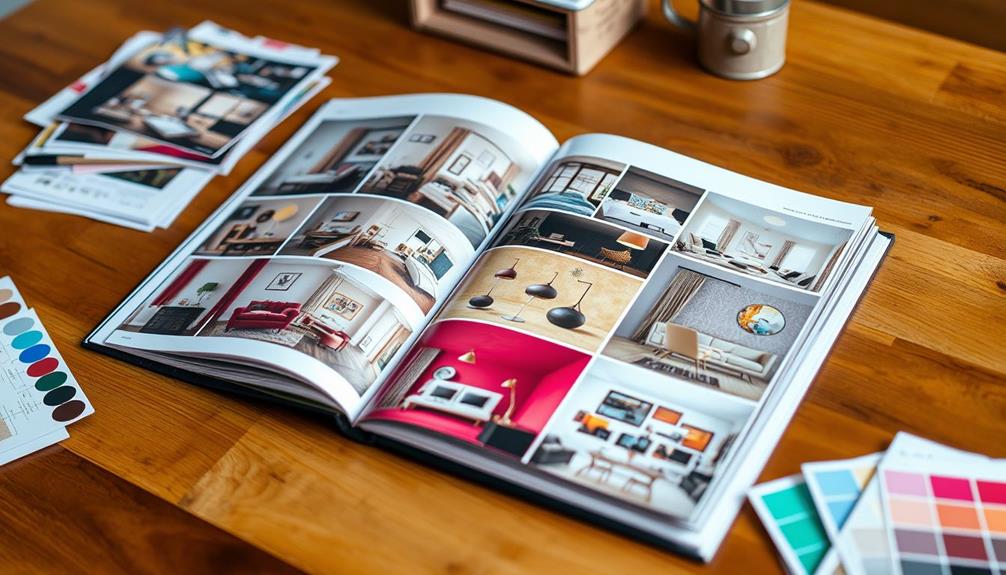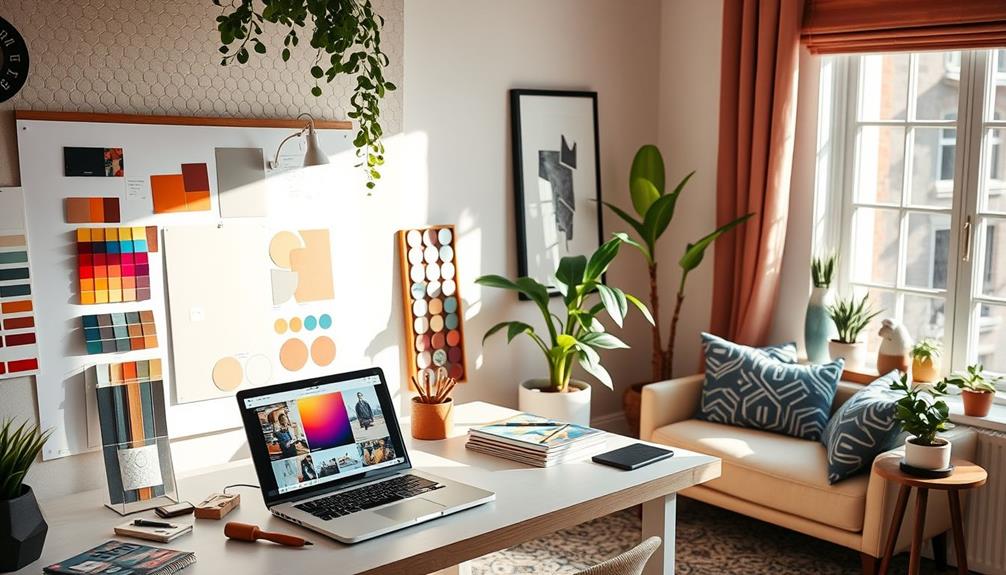To attract new interior design clients, focus on building trust with heartfelt testimonials and optimize your online presence with a standout portfolio. Engage your audience through social media, using high-quality visuals to showcase your work. Implement referral programs that reward past clients for recommendations. Stay connected with your clients by building an email list and sending regular updates. Networking within your community can also open doors to new opportunities. By combining these strategies, you'll create a strong foundation for your business and watch your client base grow. Discover more effective techniques to enhance your reach and impact.
Key Takeaways
- Build trust with potential clients by showcasing heartfelt testimonials and implementing referral programs to encourage word-of-mouth recommendations.
- Create a visually appealing portfolio that highlights your design niche and versatility, regularly updating it with high-quality images of completed projects.
- Optimize your online presence with a mobile-friendly website, localized keywords, and an active Google My Business account to improve visibility and client engagement.
- Foster exceptional client experiences through transparent communication, structured onboarding, and follow-ups to encourage repeat business and referrals.
- Utilize content marketing and social media advertising to showcase your expertise, engage potential clients, and drive traffic to your services.
Drive Referrals Through Testimonials
When it comes to attracting new clients, nothing beats the power of a heartfelt testimonial. These testimonials don't just highlight client experiences; they build trust with potential customers and can even enhance your brand's personality, much like engaging fun personality quizzes for kids help children understand their traits.
After completing a project, request testimonials from satisfied clients. With 72% of consumers trusting online reviews as much as personal recommendations, this step is essential.
Implementing a structured feedback system allows you to regularly gather client experiences, creating a repository of positive reviews that enhances your credibility. Additionally, encourage clients to share their experiences with friends and family. Word-of-mouth referrals can generate up to 50% of all purchasing decisions in service-based industries, making it a powerful marketing strategy for interior design.
Consider offering a reward scheme for clients who refer new business. Studies show that incentivized referrals notably boost conversion rates.
Finally, showcase these testimonials prominently on your website and social media platforms. Businesses that display reviews can see a 20% increase in conversion rates, helping you attract and retain clients more effectively.
Create a Stand-Out Portfolio

Creating a stand-out portfolio is vital for showcasing your design skills and attracting new clients. To grab the attention of potential interior design clients, start by clearly defining your design niche. This helps you target ideal clients who resonate with your style.
Consider incorporating elements from popular design trends, such as modern farmhouse aesthetics, to appeal to a wider audience. Include a variety of completed projects to highlight your versatility and unique capabilities, appealing to a broader audience.
Don't underestimate the power of visual appeal. Plan your photoshoots carefully, using best lighting and staging to enhance the presentation of your work. Before and after photos can be especially effective, visually demonstrating your design transformations and the impact of your skills.
Regular updates are essential for keeping your portfolio relevant and engaging. By showcasing your most recent projects, you demonstrate ongoing growth and commitment to quality in your design work. This not only keeps your portfolio fresh but also signals to potential clients that you're active and invested in your craft.
With a well-curated portfolio that reflects your style and expertise, you'll be well on your way to attracting more interior design clients and growing your business.
Build Your Email List

A standout portfolio can attract attention, but it's your email list that keeps potential clients engaged and informed. In the competitive interior design industry, building your email is essential for lead generation and maintaining a steady stream of ideal clients.
Additionally, leveraging social proof can enhance your credibility and encourage sign-ups, making your email list even more valuable. Here are three effective ways to grow your email list:
- Utilize Free Platforms: Start with tools like ConvertKit or Mailchimp. They let you manage subscribers and create engaging newsletters without any upfront costs.
- Capture Potential Clients: Use website pop-ups, landing pages, and incentives on social media to encourage sign-ups. This strategy can boost your email sign-ups by up to 1,375%, according to OptinMonster.
- Engage Regularly: Send monthly newsletters packed with valuable design tips, project highlights, and service reminders. This keeps your brand top-of-mind and encourages repeat business.
Don't forget to implement a welcoming thank-you sequence for new subscribers. This provides immediate value and fosters ongoing engagement with your services.
Leverage Social Media Advertising

Harnessing the power of social media advertising can considerably elevate your interior design business. To attract new clients, focus on visually-driven platforms like Instagram and Pinterest, where 80% of users discover new products and services. By showcasing your stunning projects through high-resolution images, you'll enhance audience engagement; after all, visual content is 40 times more likely to be shared than other types.
Consistency is key. Brands that post regularly see up to 67% more engagement, so make sure you keep your feed active and fresh.
In addition, consider implementing targeted ads on social media platforms. These ads generate three times the return on investment compared to traditional methods, making them a savvy choice for interior design firms looking to expand their reach.
Don't forget to engage with your audience through comments and messages. Positive interactions can lead to recommendations, as 71% of consumers who've a good experience with a brand on social media are likely to share it.
Utilize Content Marketing

Utilizing content marketing can greatly boost your visibility and attract new interior design clients. By creating valuable, engaging content, you can connect with potential clients and showcase your expertise in the industry.
Here are three effective strategies to get you started:
- Regular Blog Posts: Publish informative articles about current design trends, tips, and tricks. This not only establishes your authority but also encourages engagement from potential clients.
- Share Success Stories: Highlight your previous projects through case studies and testimonials. Sharing these stories helps build trust with potential clients and demonstrates your capabilities in transforming spaces.
- Localized Content: Create articles that address design trends specific to your community. This makes your content more relevant to local clients, enhancing your connection with them and increasing your chances of being their go-to designer.
Optimize Your Online Presence

Building on your content marketing efforts, optimizing your online presence is key to attracting new interior design clients. Start by ensuring your website is mobile-friendly and includes a clear call to action; a staggering 61% of users won't return if they face accessibility issues.
Regularly update your online portfolio with high-resolution images and recent projects, showcasing before and after photos to engage potential clients.
Utilize SEO best practices by incorporating localized keywords related to Local Interior Design. This helps increase visibility since 46% of Google searches are for local information.
Don't forget to create a Google My Business account and actively solicit reviews. Positive feedback can boost your click-through rates by up to 28%.
Also, actively participate in local Facebook groups. Provide valuable, non-promotional advice to build trust and establish yourself as an expert.
By optimizing your online presence, you help interior designers find your design services more easily, making it easier for potential clients to connect with you.
Consider using Google Ads to further amplify your reach. With these strategies, you'll be well on your way to attracting new clients.
Network Within Your Community

Networking within your community is a powerful way to attract new interior design clients. By engaging in local events and building relationships, you can enhance your visibility and create valuable connections. Incorporating a modern farmhouse aesthetic can appeal to many homeowners, as current trends emphasize neutral color palettes with earthy tones.
Here are three effective strategies to help you network:
- Join the local chamber of commerce: Attend events to meet potential clients and industry professionals. This can greatly boost your presence in the community and open doors to new referrals.
- Host workshops or free design classes: Showcase your expertise while drawing local interest. By offering valuable knowledge, you'll engage attendees and create opportunities for networking.
- Collaborate with local businesses: Team up with real estate agents or contractors. This collaboration can lead to mutually beneficial referrals, expanding your client base and enhancing your reputation in the community.
Additionally, participating in community projects or sponsoring local events builds goodwill and increases your visibility.
Don't forget to use social media to geotag your posts and connect with local influencers. By actively networking within your community, you'll not only attract clients but also establish long-lasting relationships that can benefit your interior design business.
Implement Referral Programs

Implementing referral programs can be a game-changer for your interior design business. By incentivizing past clients to recommend your services, you can boost client acquisition by 5-10%. Offering rewards like discounts or gift cards for successful referrals encourages satisfied clients to actively share your services.
To maximize the effectiveness of your referral program, consider the following:
| Action | Benefit |
|---|---|
| Communicate regularly with past clients | Keeps your referral program top of mind |
| Create a simple referral process | Guarantees clients understand how to participate |
| Showcase testimonials from referred clients | Enhances credibility and trust |
| Offer enticing rewards | Motivates clients to refer others |
Provide Exceptional Client Experience

Deliver exceptional client experiences and watch your interior design business thrive. Focusing on client satisfaction not only fosters trust but also encourages repeat clients and referrals.
Here are three key strategies to enhance your client experience:
- Structured Onboarding: Implement a clear onboarding process to boost initial client perceptions by up to 30%. This sets a positive tone for your working relationship and demonstrates professionalism.
- Transparent Communication: Keep your clients informed with regular project updates. By ensuring transparency, you can reduce the likelihood of misunderstandings by 50%, building trust and fostering a positive atmosphere.
- Follow-Up After Completion: Don't forget to check in with clients post-project. Following up maintains relationships and encourages repeat business, as 70% of clients prefer working with designers they've previously hired.
Frequently Asked Questions
How Do I Get More Clients as an Interior Designer?
To get more clients, focus on consistent lead generation through outreach and networking. Build your online presence with a professional website, showcase your portfolio, and leverage social media for visibility. Don't forget referral incentives!
How Do I Get My First Interior Design Client?
To get your first interior design client, tap into your personal network for referrals, create an eye-catching portfolio, and leverage social media. Offering free consultations can also showcase your skills and attract interest. In addition, attending local networking events and joining professional organizations can help you connect with potential clients. Once you start working with clients, it’s important to prioritize interior design client files organization to keep track of project details, notes, and important documents. This will help you stay organized and provide better service to your clients.
How Do I Market Myself as an Interior Designer?
To market yourself as an interior designer, create a stunning portfolio, engage on social media, share your expertise through blogs, network locally, and build an email list. These steps will amplify your visibility and attract clients.
Do Interior Designers Have to Find Clients?
Yes, interior designers have to find clients. Relying on referrals alone can limit your growth. You'll need to actively engage in marketing strategies, build a portfolio, and network to attract new business opportunities.
Conclusion
In the competitive world of interior design, securing clients is more than just talent—it's about strategy. By weaving together referrals, a stunning portfolio, and a strong online presence, you'll create a tapestry of success. Remember, every interaction is an opportunity; treat your clients like gold, and they'll shine your name throughout their networks. So, are you ready to transform your passion into a thriving business? The next client could be just around the corner!







